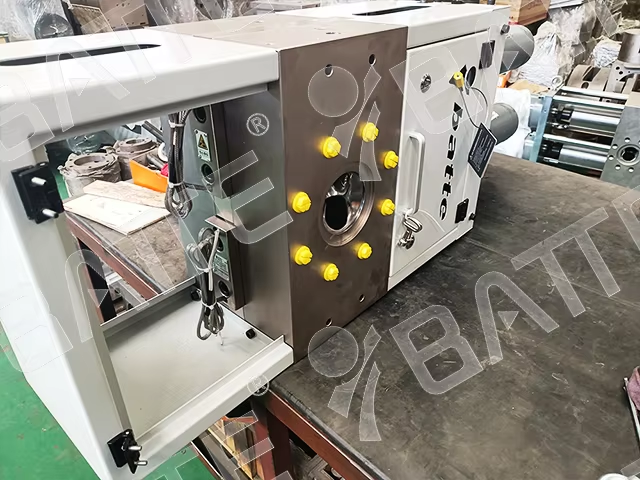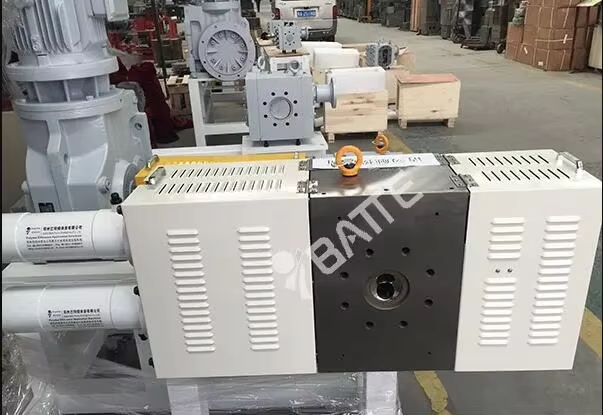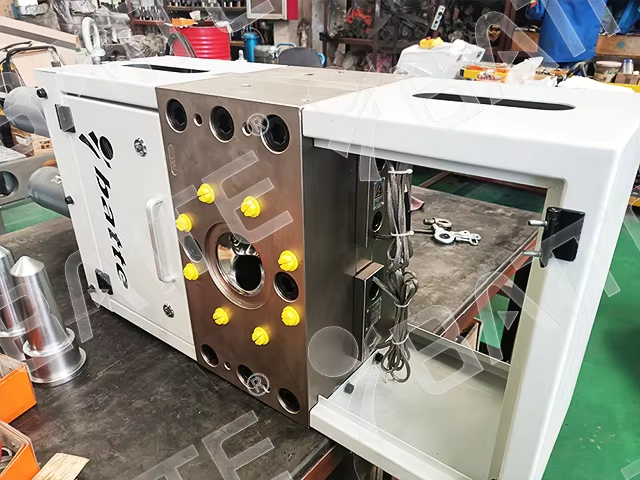Dual-plate granulating hydraulic screen changer
I. Core Definition and Working Principle
The dual-plate granulating hydraulic screen changer is a critical device in plastic product manufacturing, particularly suitable for processes such as extrusion granulation, film blowing, and pipe production of thermoplastic plastics. Its design centers on a dual-channel, dual-station configuration, with two internal parallel sliding plates operating alternately to ensure uninterrupted screen changing:
Working State: The melt enters the screen changer from the extruder and is分流 into two parallel channels, where impurities are filtered through respective screens.
Screen Changing Process: When impurities on the screen trigger a pressure alarm, the hydraulic system drives one sliding plate out for screen replacement, while the other continues to operate, achieving seamless switching.

II. Core Advantages
High-Efficiency Continuous Production
Alternating operation of dual stations, extremely short screen changing time (with energy-storage hydraulic station), significantly enhancing production efficiency.
Stable Output Quality
Minimal pressure fluctuations during screen changing, uniform product quality, reduced defective rate.
Excellent Sealing Performance
Employing flexible pressure-activated sealing or circulating water cooling and solidification technology to prevent melt leakage.
Wide Applicability
Suitable for various plastics such as PP, PE, ABS, etc., withstanding high pressure of 35MPa and high temperature of 300℃.
Low Maintenance Cost
Automated operation reducing manual intervention, convenient screen replacement, less waste.
III. Limitations
High Initial Investment
Complex structure, requiring a supporting hydraulic station, higher equipment cost than single-plate screen changers.
High Maintenance Requirements
Hydrauli c oil needs regular replacement, cleanliness needs strict monitoring, otherwise prone to failure.
Operation Threshold
Requires skilled workers to operate, avoiding equipment damage caused by misoperation.

IV. Operation and Maintenance Points
Safety Regulations
Before screen changing, it is necessary to stop the machine and relieve pressure. Lubrication-free operation is strictly prohibited to prevent scratching the sealing surface.
Screen Changing Process
Trigger alarm → prepare new screen → start hydraulic station → move sliding plate out for cleaning → reset and continue production.
Routine Maintenance
Hydraulic Check: Regularly inspect oil level, oil leakage, and replace aged hydraulic oil.
Screen Management: Set pressure thresholds based on production cycles to avoid screen rupture.
Heating System: Ensure uniform temperature to prevent equipment damage from localized overheating.
V. Typical Application Scenarios
Large-scale Granulation Production Lines: Such as cable sheath granulation, masterbatch production, requiring continuous extrusion and sensitive to impurities.
High-Temperature and High-Pressure Processes: Such as high-temperature plastic processing of PET, PVB, etc., relying on equipment's temperature and pressure resistance.
Automation Upgrade Needs: Upgrading traditional single-station screen changers to enhance overall production line efficiency.

VI. Selection Suggestions
Small and Medium-sized Production Lines: Prioritize cost, single-column screen changers can be selected.
Large-scale Continuous Production: Dual-plate hydraulic screen changers offer higher cost-effectiveness with significant long-term benefits.
For further details on specific brands, models, or technical parameters, please provide more information for targeted answers.
Email: info@battemachinery.com
WhatsApp: +86 158 38331071